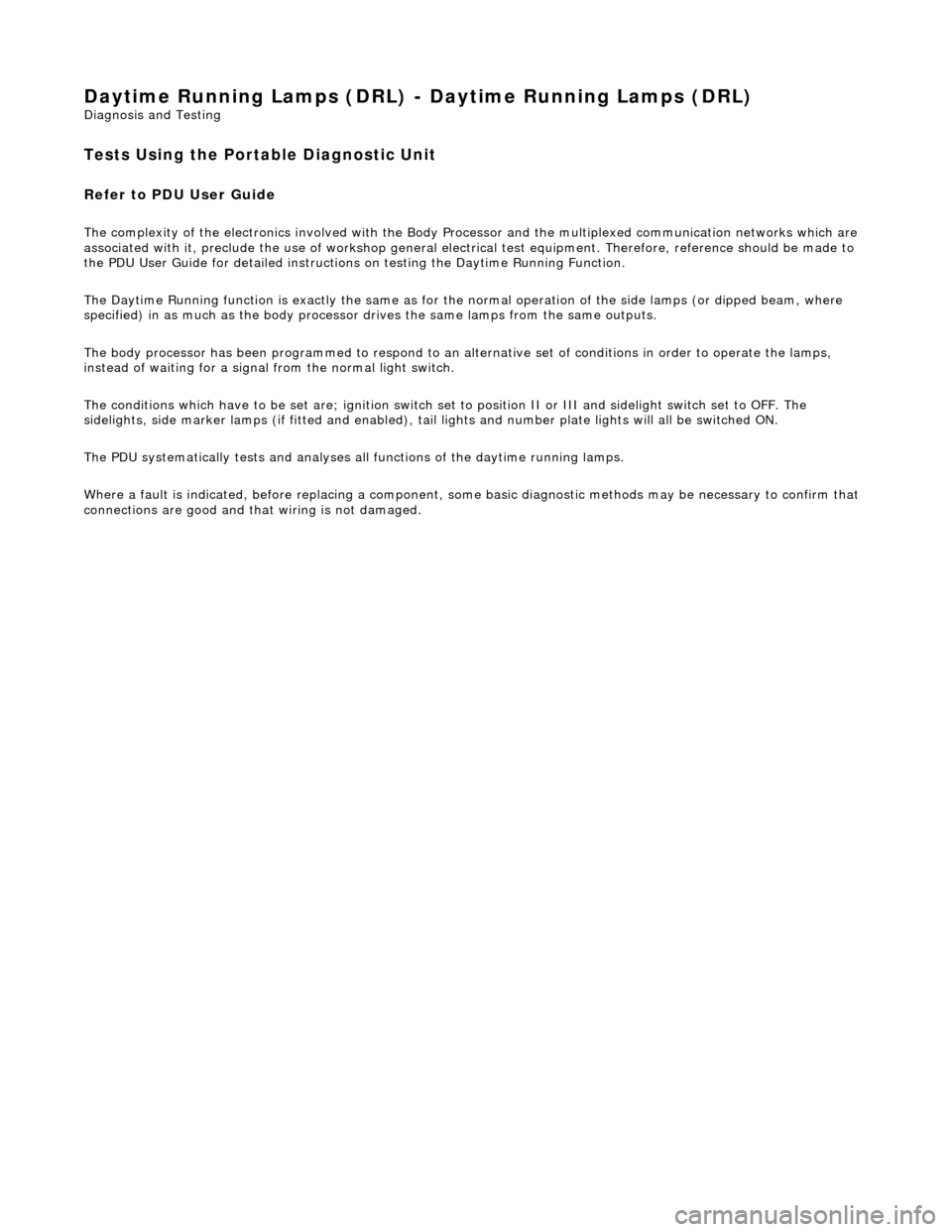Page 1964 of 2490

Interior Lighting - Interior Lighting
Diagnosis and Testing
Tests Using the Portable Diagnostic Unit
Refer to PDU User Guide
The complexity of the electronics involved with the various Electronic Control Modules and the multiplexed communication
networks, preclude the use of workshop general electrical test equipment. Therefore, reference should be made to the PDU
User Guide for detailed inst ructions on testing the interior lamps and circuits.
The PDU systematically tests and analyses the lamp assemblies, the bulbs and the electrical connections to them. It should
be noted that the lamps are not wired directly to the switches.
The lamps are controlled directly by the Bo dy Processor (it has a sufficient number of high power output stages to drive the
lamps / relays compared to other module s) except for the door guard / puddle lamps and the rear passenger reading lamps.
The Body Processor Module receives messages on the SCP network from the door modules relating to door ajar / closed /
locked status, sensed by the door courtesy switch(es).
Where a fault involving a lamp is indicated by the PDU, be fore replacing suspect components, some basic diagnostic
methods may be necessary to confirm that connecti ons are good and that wiring is not damaged.
Page 1965 of 2490
Interior Lighting - Door Courtesy Lamp
Removal and Installation
Removal
Installation
1.
Remove front door casing fo r access. Refer to 76.34.01.
2. Remove the two lamp assembly securing screws.
3. Withdraw lamp assembly from door casing.
1. Position lamp assembly on door casing.
2. Install lamp securing screws.
3. Install door casing. Refer to 76.34.01.
Page 1966 of 2490
Interior Lighting - Door Courtesy Lamp Bulb
Removal and Installation
Removal
Installation
1. Using a thin plastic bl ade, carefully release lens retaining tang
from guard lamp assembly.
2. Withdraw lens from gu ard lamp assembly.
3. Remove bulb from bulb holder.
1. Install bulb in holder.
2. Position lens on guard lamp assembly.
3. Press lens firmly to fully seat securing tang in guard lamp
assembly..
Page 1967 of 2490
Interior Lighting - Door Courtesy Lamp Lens
Removal and Installation
Removal
Installation
1. Using a thin plastic bl ade, carefully release lens retaining tang
from guard lamp assembly.
2. Withdraw lens from gu ard lamp assembly.
1. Position lens on guard lamp assembly.
2. Press lens firmly to fully seat securing tang in guard lamp
assembly..
Page 1968 of 2490
Interior Lighting - Glove Compartment Lamp
Removal and Installation
Removal
Installation
1.
Open glovebox lid.
2. Carefully release and remove plas tic lens from glovebox light.
3. Remove bulb from glovebox light.
4. Release light/switch assembly retaining tangs and partially
withdraw assembly from glovebox exterior.
5. Position light/switch assembly for access, disconnect harness
spade connectors and remove assembly from glovebox
aperture.
1. Position light/switch assembly at glovebox aperture and
connect harness spade connectors.
2. Install assembly in aperture, en suring that retaining tangs are
fully seated.
3. Install bulb in light/switch assembly and check that harness
leads are clear of bulb.
4. Install plastic lens to light/switch assembly.
5. Close glovebox lid.
Page 1969 of 2490
Interior Lighting - Luggage Compartment Lamp
Removal and Installation
Removal
Installation
1.
Remove battery cover and disc onnect ground cable from
battery terminal.Refer to 86.15.19.
2. Carefully release lamp tangs from trunk lid trim, position lamp
for access, disconnect harness multiplug and remove lamp from trunk.
1. Position lamp at trunk lid and connect harness multiplug.
2. Ensuring that harness is routed correctly, finally position and
fully seat lamp in trunk lid liner.
3. Connect ground cable to battery terminal and fit battery cover.
Refer to 86.15.15.
Page 1970 of 2490
Interior Lighting - Vanity Mirror Lamp
Removal and Installation
Removal
Installation
1.
Release sun visor from retention bezel to isolate from electrical
supply.
2. Move sun visor to downward position and turn mirror cover
upwards.
3. Using a small screwdriver, carefu lly release illumination lens
tangs from vanity assembly.
4. Supporting vanity assembly, sl acken and remove securing
screws and remove assembly from sun visor.
1. Ensure that bulb holders and sw itch contactors are correctly
positioned and seated.
2. Position and fully seat vanity as sembly on sun visor and fit and
tighten securing screws.
3. Fit and fully seat mirror illumination lenses.
4. Turn mirror cover downwards.
5. Reposition sun visor in retentio n bezel and return to upward
position.
Page 1972 of 2490

Daytime Running Lamps (DRL) - Daytime Running Lamps (DRL)
Diagnosis and Testing
Tests Using the Portable Diagnostic Unit
Refer to PDU User Guide
The complexity of the electronics involved with the Body Pr ocessor and the multiplexed communication networks which are
associated with it, preclude the use of wo rkshop general electrical test equipment. Therefore, reference should be made to
the PDU User Guide for detail ed instructions on testing the Daytime Running Function.
The Daytime Running function is exactly the same as for the normal operation of the side lamps (or dipped beam, where
specified) in as much as the body processor drives the same lamps from the same outputs.
The body processor has been programmed to respond to an alternative set of cond itions in order to operate the lamps,
instead of waiting for a signal from the normal light switch.
The conditions which have to be set are; ignition switch se t to position II or III and sidelight switch set to OFF. The
sidelights, side marker lamps (if fitted and enabled), tail lights and number plate lights will all be switched ON.
The PDU systematically tests and analyses all functions of the daytime running lamps.
Where a fault is indicated, before replac ing a component, some basic diagnostic methods may be necessary to confirm that
connections are good and that wiring is not damaged.